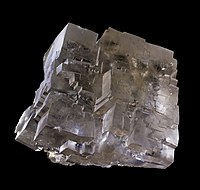
Photo from wikipedia
Arc magmas are thought to be generated by partial melting of the mantle wedge above the subduction slab, which is triggered by the fluids from the dehydration of subducting oceanic… Click to show full abstract
Arc magmas are thought to be generated by partial melting of the mantle wedge above the subduction slab, which is triggered by the fluids from the dehydration of subducting oceanic crust. Among the dehydration reactions, those occurring at the depths of the blueschist-to-eclogite transition are considered to be very important. The sodium amphibole glaucophane (□Na2Mg3Al2Si8O22(OH)2, where □ represents a vacancy) is characteristic of blueschists, so that determining the higher-temperature stability of end-member glaucophane helps constrain the maximum temperature of the transition between blueschists and eclogites. A reversed determination of the dehydration reaction 2 glaucophane = 4 jadeite + 3 enstatite + 2 quartz + 2 H2O was done in the system Na2O–MgO–Al2O3–SiO2–H2O over the pressure-temperature (P–T) range of 2·5–3·3 GPa and 760–900 °C for durations of 24–96 hours, using synthetic phases as starting materials. The reaction was bracketed at 830–850 °C at 2·5 GPa and at 810–830 °C at 2·9 GPa in the presence of water. In addition to pure water, 5 molality H2O–NaCl (mole fraction XNaCl = 0·08) and 5 molality H2O–CO2 (XCO2 = 0·08) fluids were used to check the effects of NaCl and CO2, respectively, on the dehydration reaction. The H2O–NaCl fluid shifts the reaction boundary at 2·5 GPa from 840 °C to a lower T (800 °C), while the CO2–H2O fluid shifts the boundary to a higher T (860 °C). At these high P–T conditions, the fluid, even without any added NaCl or CO2, is a silicate-bearing aqueous fluid. The different effects of NaCl and CO2 are attributed to differences in their capabilities to inhibit the solubility of silicates, such as quartz in water, and in changing the activity of water at such P–T conditions. The difference can shift the depth of dehydration by 6 km for an average low dT/dP geothermal gradient of 325 °C/GPa. The shift in the boundary could be considerably larger for shallower dT/dP slab-top geothermal gradients. The experimental results show a good fit with those from thermodynamic modelling and aqueous geochemical calculation.
Journal Title: Journal of Petrology
Year Published: 2019
Link to full text (if available)
Share on Social Media: Sign Up to like & get
recommendations!